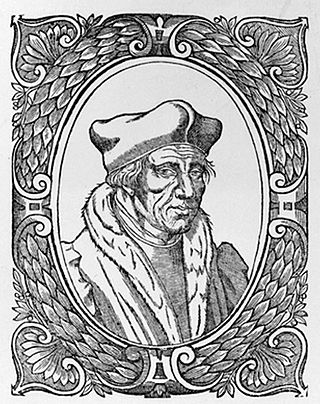Related Research Articles
Year 1463 (MCDLXIII) was a common year starting on Saturday of the Julian calendar, the 1463rd year of the Common Era (CE) and Anno Domini (AD) designations, the 463rd year of the 2nd millennium, the 63rd year of the 15th century, and the 4th year of the 1460s decade.
This article presents lists of literary events and publications in the 16th century.
This article contains information about the literary events and publications of 1545.
This article contains information about the literary events and publications of 1528.
This article presents lists of the literary events and publications in 1524.
This article contains information about the literary events and publications of 1520.
This article contains information about the literary events and publications of 1503.

Jacques Lefèvre d'Étaples was a French theologian and a leading figure in French humanism. He was a precursor of the Protestant movement in France. The "d'Étaples" was not part of his name as such, but used to distinguish him from Jacques Lefèvre of Deventer, a less significant contemporary who was a friend and correspondent of Erasmus. Both are also sometimes called by the German version of their name, Jacob/Jakob Faber. He himself had a sometimes tense relationship with Erasmus, whose work on biblical translation and in theology closely paralleled his own.

Antonio Tabucchi was an Italian writer and academic who taught Portuguese language and literature at the University of Siena, Italy. Deeply in love with Portugal, he was an expert, critic and translator of the works of Fernando Pessoa from whom he drew the conceptions of saudade, of fiction and of the heteronyms. Tabucchi was first introduced to Pessoa's works in the 1960s when attending the Sorbonne. He was so charmed that when he returned to Italy, he took an introductory course in Portuguese for a better comprehension of the poet.
Zanobi Acciaioli was an Italian Dominican friar, a member of the Acciaioli family of Florence. He was Librarian of the Vatican under Leo X. He joined the Dominican convent on 8 December 1495. He learned Greek and Hebrew towards the latter part of his life, and was appointed in 1518 prefect of the Vatican Library.

Humanism in France found its way from Italy, but did not become a distinct movement until the 16th century was well on its way.
Nationality words link to articles with information on the nation's poetry or literature.
Events from the year 1730 in art.
The decade of the 1540s in music involved some significant events.
Henri Estienne also known as Henricus Stephanus, was a 16th-century Parisian printer. Born in Paris in 1460 or 1470, he was the son of Geoffroy d'Estienne and Laure de Montolivet. His brother Raimond d'Estienne became the heir of the Estienne family, while Henri was disinherited by his father in 1482 "for having devoted himself to printing", the profession of printer then being the cause of losing your title. Estienne established the Estienne printing firm in 1502 from his wife's deceased husband's Higman Press. After his death in 1520, his wife married his colleague Simon de Colines who took control of the Estienne Press until his son Robert Estienne assumed control of the press in 1526.
Bible translations into French date back to the Medieval era. After a number of French Bible translations in the Middle Ages, the first printed translation of the Bible into French was the work of the French theologian Jacques Lefèvre d'Étaples in 1530 in Antwerp. This was substantially revised and improved in 1535 by Pierre Robert Olivétan. This Bible, in turn, became the basis of the first French Catholic Bible, published at Leuven in 1550, the work of Nicholas de Leuze and François de Larben. Finally, the Bible de Port-Royal, prepared by Antoine Lemaistre and his brother Louis Isaac Lemaistre, finished in 1695, achieved broad acceptance among both Catholics and Protestants. Jean-Frédéric Ostervald's version (1744) also enjoyed widespread popularity.

Simon de Colines was a Parisian printer and one of the first printers of the French Renaissance. He was active in Paris as a printer and worked exclusively for the University of Paris from 1520 to 1546. In addition to his work as a printer, Colines worked as an editor, publisher, and punchcutter. Over the course of his lifetime, he published over 700 separate editions. Colines used elegant roman and italic types and a Greek type, with accents, that were superior to their predecessors. These are now called French old-style, a style that remained popular for over 200 years and revived in the early 20th century. He used rabbits, satyrs, and philosophers as his pressmark.
The year 1588 in science and technology, Armada year, included a number of events, some of which are listed here.
References
- ↑ Veyrin-Forrer, Jeanne (1995). "Introduction". In schreiber, Fred (ed.). Simon de Colines: An annotated catalog of 230 examples of his press, 1520–1546. Provo, Utah: Friends of the Brigham Young University Library. pp. xlix.
- 1 2 Cox, Michael, ed. (2004). The Concise Oxford Chronology of English Literature . Oxford University Press. ISBN 0-19-860634-6.
- ↑ Kurian, George Thomas (2003). Timetables of World Literature. New York: Facts on File Inc. ISBN 0-8160-4197-0.
- ↑ Original text. Retrieved 25 May 2020.
- ↑ Favaro, Antonio [in Italian] (1886). Carteggio inedito di Ticone Brahe: Giovanni Keplero e di altri celebri astronomi e matematici dei secoli XVI. e XVII. con Giovanni Antonio Magini, tratto dall'Archivio Malvezzi de' Medici in Bologna (in Italian). Bologna: Nicola Zanichelli. pp. 314–315. OCLC 559767244.